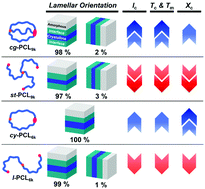Topologically controlled phase transitions and nanoscale film self-assemblies of cage poly(ε-caprolactone) and its counterparts†
Abstract
Here we report the first quantitative investigation of nanoscale film morphologies of a cage-shaped poly(ε-caprolactone) (cg-PCL9k) and its counterparts in star, cyclic, and linear topologies (st-PCL9k, cy-PCL6k, and l-PCL6k) with consideration of topological influence through synchrotron grazing incidence X-ray scattering analysis. The folded crystalline layer thickness lc is found to be in the increasing order of: st-PCL9k < l-PCL6k < cy-PCL6k < cg-PCL9k. Additional structural parameters, such as lamellar orientation, crystallinity, and orientation of orthorhombic lattice in nanoscale film, exhibit intricate dependencies on their molecular topologies and steric influences from the molecular joints and end groups. Nevertheless, all topological PCLs form lamellar structures based on the orthorhombic crystal lattice in nanoscale films. In addition, crystallization temperature Tc and crystal melting temperature Tm of all PCLs in bulk are highly dependent on the molecular topology; both Tc and Tm follow the same increasing trend of: st-PCL9k < l-PCL6k < cy-PCL6k < cg-PCL9k. Phase transition characteristics such as heat of fusion and crystallinity in bulk state, and thermal stability also depend upon the topological and steric influences.



 Please wait while we load your content...
Please wait while we load your content...